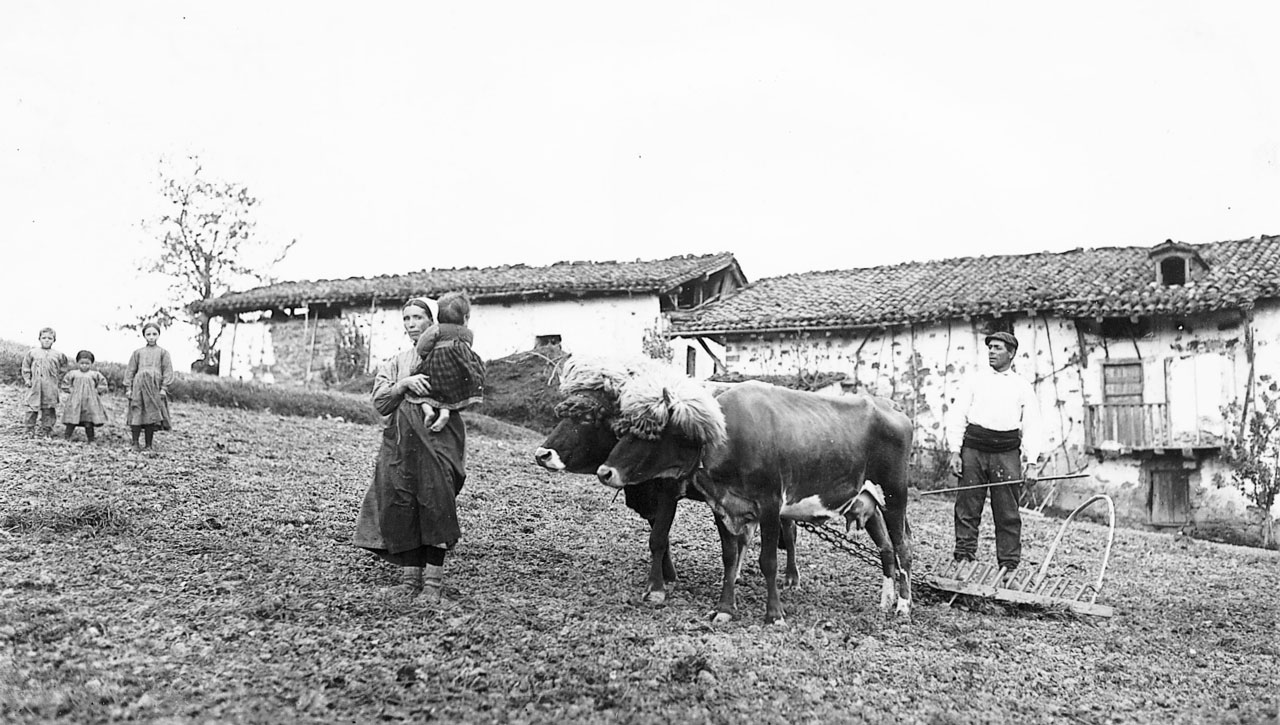Diferencia entre revisiones de «Casa y familia en vasconia/en»
De Atlas Etnográfico de Vasconia
(Página creada con «===Outstanding contents=== ====[/images/thumb/d/d7/2.59_Caserios_dispersos._Kortezubi_(B)_2011.jpg/1200px-2.59_Caserios_dispersos._Kortezubi_(B)_2011.jpg|House and Family i...») |
(Actualizando para coincidir con nueva versión de la página fuente) |
||
| Línea 1: | Línea 1: | ||
_LABAYRU_LANDING_ | _LABAYRU_LANDING_ | ||
| + | <languages /> | ||
{{DISPLAYTITLE: Casa y Familia en Vasconia}} | {{DISPLAYTITLE: Casa y Familia en Vasconia}} | ||
| − | {{#bookTitle: | + | {{#bookTitle:Casa y Familia en Vasconia | Casa_y_familia_en_vasconia}} |
==[landing]== | ==[landing]== | ||
| − | ===[casa| | + | ===[casa|Casa y familia en Vasconia|/atlas/casa.png|La casa tradicional bajo una mirada que va más allá de lo puramente arquitectónico.]=== |
| − | ====[Casa_y_familia_en_vasconia | + | ====[Casa_y_familia_en_vasconia | Casa y Familia en Vasconia]==== |
| − | ====[/atlas/casa/Abuela-con-los-nietos-Urduliz-2011.jpg| | + | ====[/atlas/casa/Abuela-con-los-nietos-Urduliz-2011.jpg|Abuela y nietos. Urduliz (B), 2011. Fuente: Akaitze Kamiruaga, Grupos Etniker Euskalerria.|La familia tradicional vasca está caracterizada por una suerte de feminismo claramente definido, como lo demuestra la aplicación del derecho de primogenitura sin distinción de sexo, el condominio de los bienes aportados al matrimonio por los esposos, la igualdad de estos en lo civil, y la jefatura de la mujer en la vida religiosa doméstica, en los ritos culturales del hogar, de la iglesia y de la sepultura familiar.]==== |
| − | ====[/atlas/casa/Colaboracion-del-matrimonio-en-el-trabajo-Zeanuri-1915.jpg| | + | ====[/atlas/casa/Colaboracion-del-matrimonio-en-el-trabajo-Zeanuri-1915.jpg|Colaboración del matrimonio en el trabajo. Zeanuri (B), c. 1915. Fuente: Archivo Fotográfico Labayru Fundazioa: Fondo Felipe Manterola.|La casa rural ha sido una institución formada por el edificio, por sus tierras, por sus moradores y por la tradición, es decir, por esa urdimbre de relaciones que enlazaba estrechamente a la generación actual con las pasadas.|]==== |
| − | ====[/atlas/casa/Muskildi-2011.jpg|Muskildi (Z), 2011. | + | ====[/atlas/casa/Muskildi-2011.jpg|Muskildi (Z), 2011. Fuente: Michel Duvert, Grupos Etniker Euskalerria.|“Con mucha razón se ha dicho que todo establecimiento humano es la amalgama de un poco de humanidad, de un poco de suelo y de un poco de agua”.|J. M. Barandiaran]==== |
| − | ====[/atlas/casa/Sanjuan-haretxa-roble-de-San-Juan-Zeanuri-1980.jpg| | + | ====[/atlas/casa/Sanjuan-haretxa-roble-de-San-Juan-Zeanuri-1980.jpg|Ramos de San Juan. Zeanuri (B), 1980. Fuente: Ander Manterola, Grupos Etniker Euskalerria.|En torno a la festividad de San Juan se practican ritos de diversa índole, como la implantación del ramo de San Juan, San Juan haretxa, en las jambas del portal.||]==== |
| − | ====[/atlas/casa/Heredero-etxegaia-de-una-familia-de-Zeanuri-1920.jpg| | + | ====[/atlas/casa/Heredero-etxegaia-de-una-familia-de-Zeanuri-1920.jpg|Heredero, etxegaia, de una familia de Zeanuri (B), c. 1920. Fuente: Archivo Fotográfico Labayru Fundazioa: Fondo Felipe Manterola.|En los territorios acogidos al derecho foral ha sido costumbre generalizada que uno de los hijos, fuera varón o mujer, continuara con la tradición familiar de mantener el caserío y sus pertenecidos.||]==== |
| − | ====[/atlas/casa/La-cocina-centro-de-la-vida-familiar-Andoain-1920.jpg| | + | ====[/atlas/casa/La-cocina-centro-de-la-vida-familiar-Andoain-1920.jpg|La cocina, centro de la vida familiar. Andoain (G), c. 1920. Fuente: Archivo Aguirre.|Gure etxean sua batzen, gure etxean aingeruak sartzen. En casa limpia los ángeles bailan de gusto.||]==== |
| − | ====[/atlas/casa/Fuego-bajo,-chapa-y-cocina-de-butano.-Ajuria-(B),-2011.jpg| | + | ====[/atlas/casa/Fuego-bajo,-chapa-y-cocina-de-butano.-Ajuria-(B),-2011.jpg|Fuego bajo, chapa y cocina de butano. Barrio Aiuria (Muxika-B), 2011. Fuente: Segundo Oar-Arteta, Grupos Etniker Euskalerria.|Etxe onak, txingar ona. De buena casa, buena brasa.||]==== |
| − | ====[/atlas/casa/Caserio-Munekogoikoa-Barrio-Urigoiti-Orozko-1994.jpg|Munekogoikoa | + | ====[/atlas/casa/Caserio-Munekogoikoa-Barrio-Urigoiti-Orozko-1994.jpg|Caserío Munekogoikoa. Barrio Urigoiti (Orozko-B), 1994. Fuente: Edurne Romarate, Grupos Etniker Euskalerria.|Los caseríos más antiguos son aquellos en los que el uso de la madera es preponderante, tanto en su estructura interna como externa.||]==== |
| − | ====[/atlas/casa/Varias-generaciones-bajo-un-mismo-techo-Zeanuri-1910.jpg| | + | ====[/atlas/casa/Varias-generaciones-bajo-un-mismo-techo-Zeanuri-1910.jpg|Varias generaciones bajo un mismo techo. Zeanuri (B), c. 1910. Fuente: Archivo Fotográfico Labayru Fundazioa: Fondo Felipe Manterola.|Etxe beteak atsegin, etxe hutsak bihotz min. Cuando la pobreza entra por la puerta, el amor salta por la ventana.||]==== |
| − | ====[/atlas/casa/Caserio-Zurutuza-Zeanuri-1925.jpg|Zurututza | + | ====[/atlas/casa/Caserio-Zurutuza-Zeanuri-1925.jpg|Caserío Zurututza. Zeanuri (B), c. 1925. Fuente: Archivo Fotográfico Labayru Fundazioa: Fondo Felipe Manterola.|Etxeko habeak, etxeko berri. Más sabe el loco en su casa que el cuerdo en la ajena.||]==== |
| − | ====[/atlas/casa/Guisando-en-fogon-bajo-Apellaniz-1981.jpg| | + | ====[/atlas/casa/Guisando-en-fogon-bajo-Apellaniz-1981.jpg|Guisando en fogón bajo. Apellániz (A), 1981. Fuente: López de Guereñu, Gerardo. “Apellániz. Pasado y presente de un pueblo alavés” in Ohitura 0, Vitoria-Gasteiz: Diputación Foral de Álava, 1981.|La cocina era en los caseríos el lugar ordinario de reunión, donde se concentraba la vida familiar.||]==== |
| − | ====[/atlas/casa/Predominio-de-tejados-de-vertiente-unica-Artajona-2010.jpg| | + | ====[/atlas/casa/Predominio-de-tejados-de-vertiente-unica-Artajona-2010.jpg|Predominio de tejados de vertiente única. Artajona (N), 2010. Fuente: Segundo Oar-Arteta, Grupos Etniker Euskalerria.|El tejado es originariamente anterior a paredes, cimientos y demás elementos constructivos de la casa.||]==== |
| − | ====[/atlas/casa/Fuego-bajo-Zeanuri-1980.jpg| | + | ====[/atlas/casa/Fuego-bajo-Zeanuri-1980.jpg|Fuego bajo. Zeanuri (B), 1980. Fuente: Ander Manterola, Grupos Etniker Euskalerria.|Su bako etxea, gorputz odol bagea. Casa sin fuego, cuerpo sin sangre.||]==== |
| − | ====[/atlas/casa/Familia-bereko-lau-belaunaldi-cuatro-generaciones-de-una-misma-familia-Ajangiz-1977.jpg| | + | ====[/atlas/casa/Familia-bereko-lau-belaunaldi-cuatro-generaciones-de-una-misma-familia-Ajangiz-1977.jpg|Cuatro generaciones de una misma familia. Ajangiz (B), 1977. Fuente: Segundo Oar-Arteta, Grupos Etniker Euskalerria.|La familia es el núcleo vertebrador de la casa, y las casas con las familias que las habitan dan consistencia y estructuran la vecindad y la sociedad.||]==== |
| − | ====[/atlas/casa/Senar-emazte-zaharrak-eta-gazteak-matrimonios-mayor-y-joven-Areatza-principios-del-siglo-20.jpg| | + | ====[/atlas/casa/Senar-emazte-zaharrak-eta-gazteak-matrimonios-mayor-y-joven-Areatza-principios-del-siglo-20.jpg|Matrimonios mayor y joven. Areatza (B), principios del siglo XX. Fuente: Archivo particular Rubén de Las Hayas.|Se procuraba que el patrimonio familiar, entendido este como la casa y sus pertenecidos, pasara íntegramente o con la menor merma, y mejorado si fuera posible, de padres a hijos.||]==== |
==[related]== | ==[related]== | ||
| − | === | + | ===Contenidos destacados=== |
| − | ====[/images/thumb/d/d7/2.59_Caserios_dispersos._Kortezubi_(B)_2011.jpg/1200px-2.59_Caserios_dispersos._Kortezubi_(B)_2011.jpg| | + | ====[/images/thumb/d/d7/2.59_Caserios_dispersos._Kortezubi_(B)_2011.jpg/1200px-2.59_Caserios_dispersos._Kortezubi_(B)_2011.jpg|Casa y familia en vasconia|Denominación, orientación y situación de las casas|[[DENOMINACION_ORIENTACION_Y_SITURACION_DE_LAS_CASAS]]]==== |
| − | ====[/images/thumb/6/6f/2.269_Casa_engalanada_con_tiestos._Elizondo_(N)_2010.JPG/1200px-2.269_Casa_engalanada_con_tiestos._Elizondo_(N)_2010.JPG| | + | ====[/images/thumb/6/6f/2.269_Casa_engalanada_con_tiestos._Elizondo_(N)_2010.JPG/1200px-2.269_Casa_engalanada_con_tiestos._Elizondo_(N)_2010.JPG|Casa y familia en vasconia|Equipo mobiliar del hogar y de la cocina|[[EQUIPO_MOBILIAR_DEL_HOGAR_Y_DE_LA_COCINA]]]==== |
| − | ====[/images/thumb/5/5e/2.334_Uretako_ontziak_recipientes_para_agua._Zerain_(G).JPG/900px-2.334_Uretako_ontziak_recipientes_para_agua._Zerain_(G).JPG| | + | ====[/images/thumb/5/5e/2.334_Uretako_ontziak_recipientes_para_agua._Zerain_(G).JPG/900px-2.334_Uretako_ontziak_recipientes_para_agua._Zerain_(G).JPG|Casa y familia en vasconia|Símbolos protectores de la casa|[[SIMBOLOS_PROTECTORES_DE_LA_CASA]]]==== |
| − | ====[/images/thumb/a/a6/2.462_El_heredero_y_los_demas_hijos_junto_a_los_padres._Sopelana_(B)_c._1920.jpg/1200px-2.462_El_heredero_y_los_demas_hijos_junto_a_los_padres._Sopelana_(B)_c._1920.jpg| | + | ====[/images/thumb/a/a6/2.462_El_heredero_y_los_demas_hijos_junto_a_los_padres._Sopelana_(B)_c._1920.jpg/1200px-2.462_El_heredero_y_los_demas_hijos_junto_a_los_padres._Sopelana_(B)_c._1920.jpg|Casa y familia en vasconia|Patrimonio familiar y su transmisión|[[PATRIMONIO_FAMILIAR_Y_SU_TRANSMISION]]]==== |
Revisión del 17:09 25 feb 2020

Casa y familia en Vasconia
La casa tradicional bajo una mirada que va más allá de lo puramente arquitectónico.
Abuela y nietos. Urduliz (B), 2011. Fuente: Akaitze Kamiruaga, Grupos Etniker Euskalerria.


,-2011.jpg)
_2011.jpg/1200px-2.59_Caserios_dispersos._Kortezubi_(B)_2011.jpg)
_2010.JPG/1200px-2.269_Casa_engalanada_con_tiestos._Elizondo_(N)_2010.JPG)
.JPG/900px-2.334_Uretako_ontziak_recipientes_para_agua._Zerain_(G).JPG)
_c._1920.jpg/1200px-2.462_El_heredero_y_los_demas_hijos_junto_a_los_padres._Sopelana_(B)_c._1920.jpg)
